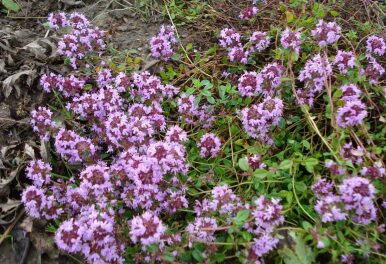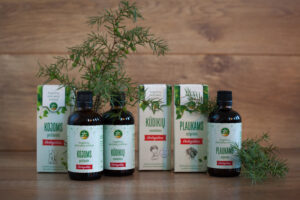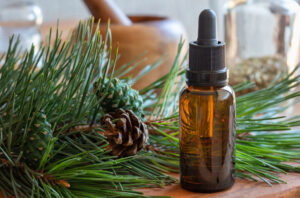Tiny thyme leaves emit essential oil, which forms a fragrant cloud above a cup of hot tea, subtly reminding of the wonderful summer days.
Thyme contains 0.12-0.27 % of essential oil. It mostly consists of thymol (about 30 %), carvacrol (about 20 %) and other components; moreover, it also contains fermenting substances, vitamin C, resins, flavonoids and organic acids.
Herbal medicine uses the soft parts of the plant growing above the ground. The herb is dried indoors or in a special dryer. The temperature in the dryer cannot be higher than 40o C. Once dried, the herbs are sieved using a metal sieve. One hectare produces up to 70 hwt of raw material. 100 kg of raw material produces 32-34 dried herbs. Dry herb is characterised by its pleasant scent, as well as slightly bitter and spicy flavour. It may contain no more than 13 % of moist, no more than 10 % of larger branches and roots, as well as no more than 1 % of organic and mineral additions.
Thyme herb infusion eliminates germs and facilitates coughing. Widely used for laryngitis, tracheitis and bronchitis treatment.
Thyme is very fragrant and can be used for vegetable, meat and fish dishes, also sauces and marinades.
Its essential oil is widely used in perfumery, food industry and liquor production.
Literature
Butkus, V., et. al. Mažieji miško turtai. Vilnius: Mokslas 1987.
Čekauskaitė, L. Gamtos vaistinėlė. Kaunas: Spindulys, 2003.
Kaunienė, V.; Kaunas, E. Vaistingieji augalai. Žinynas. Kaunas: Varpas, 1991.
Obelevičius, K; Petkevičiūtė, S; E. Šeinauskienė, E. Prieskoninių augalų ir jų vartojimo žinynas. Kaunas: Lututė, 2011.
Ragažinskienė, O.; Rimkienė, S.; Sasnauskas, V. Vaistinių augalų enciklopedija. Kaunas: Lututė, 2005.





